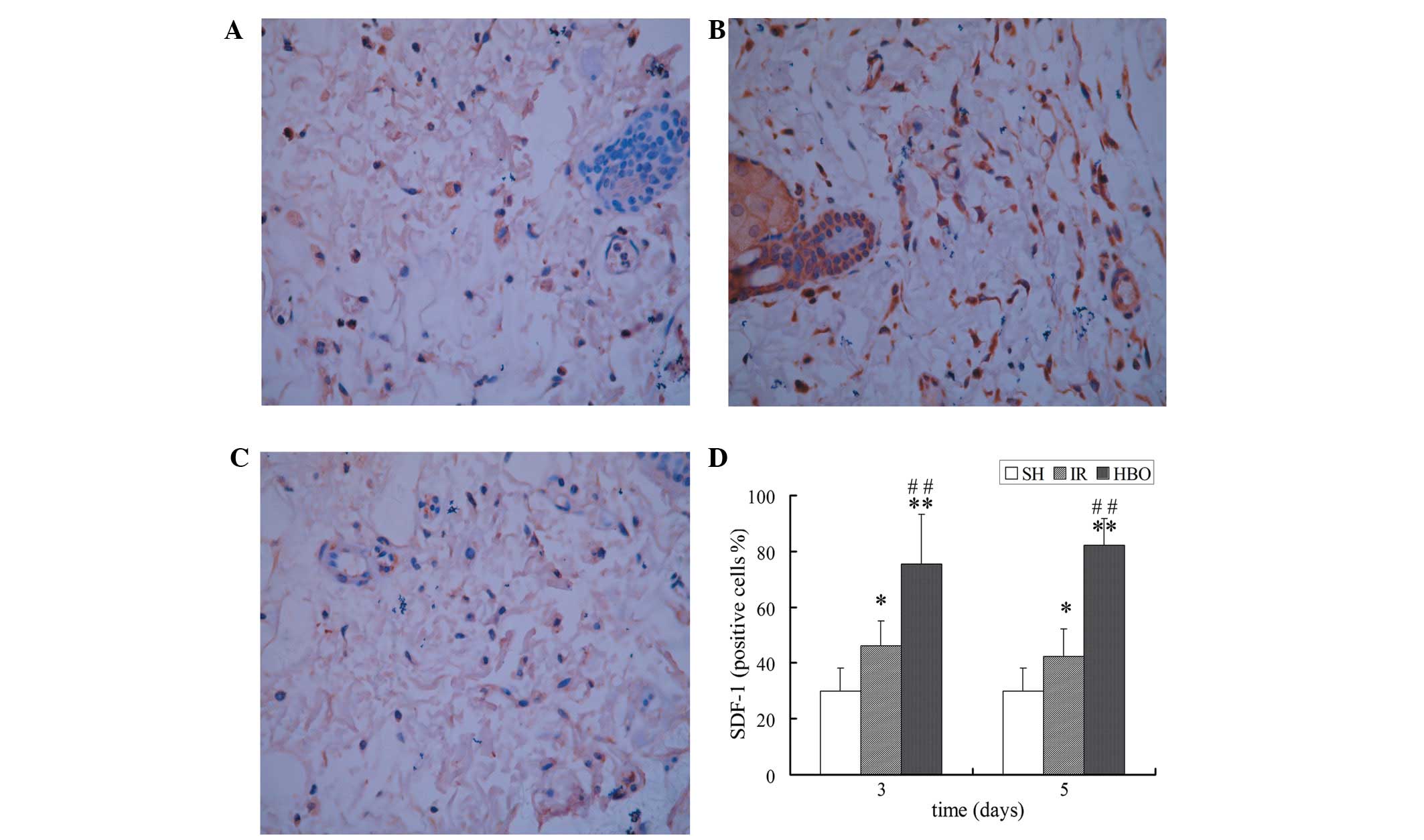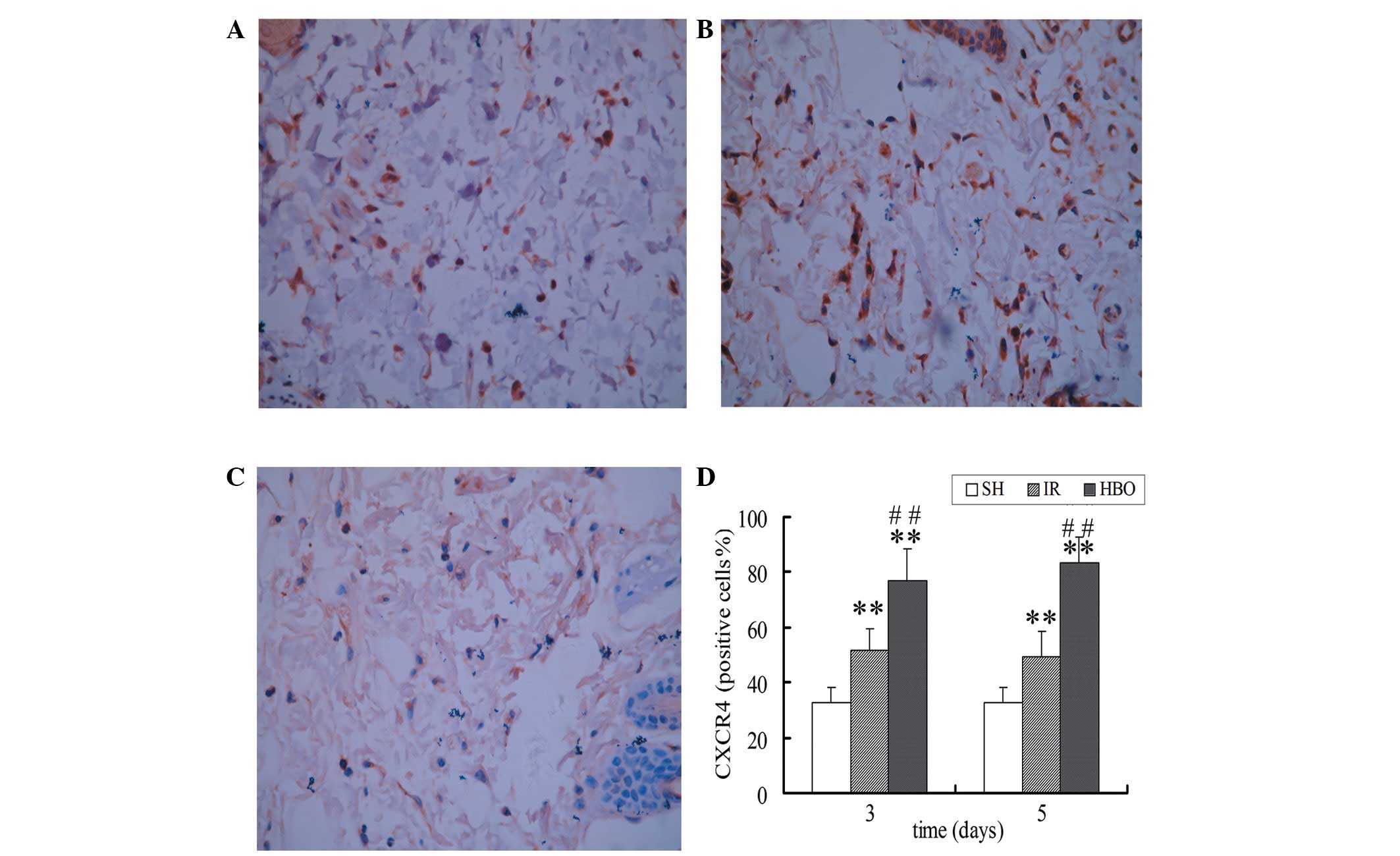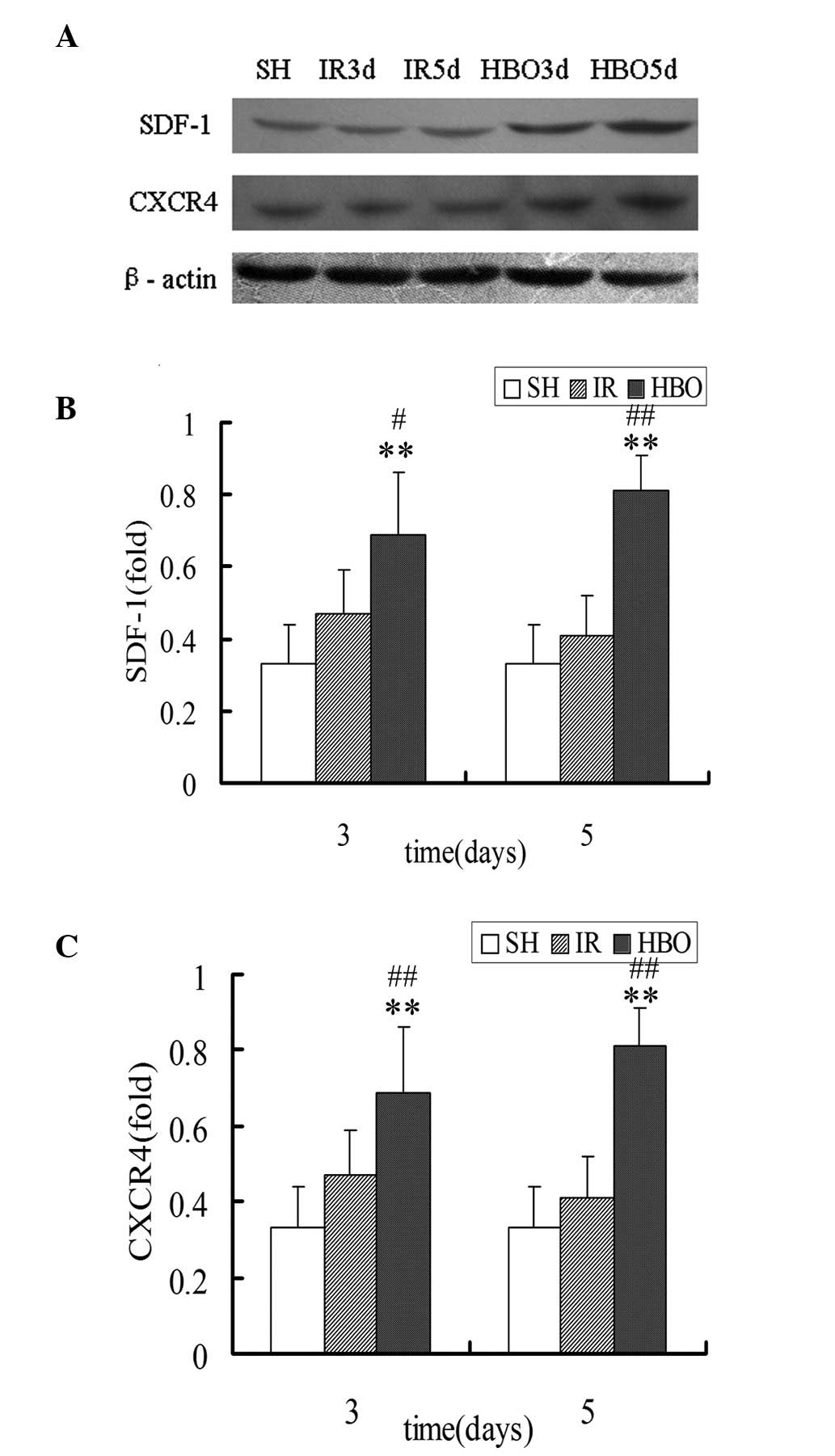|
1
|
Kryger Z, Zhang F, Dogan T, Cheng C,
Lineaweaver WC and Buncke HJ: The effects of VEGF on survival of a
random flap in the rat: examination of various routes of
administration. Br J Plast Surg. 53:234–239. 2000. View Article : Google Scholar : PubMed/NCBI
|
|
2
|
Lu WW, Ip WY, Jing WM, Holmes AD and Chow
SP: Biomechanical properties of thin skin flap after basic
fibroblast growth factor (bFGF) administration. Br J Plast Surg.
53:225–229. 2000. View Article : Google Scholar : PubMed/NCBI
|
|
3
|
de Souza Filho MV, Loiola RT, Rocha EL,
Simão AFL and Ribeiro RA: Remote ischemic preconditioning improves
the survival of rat random-pattern skin flaps. Eur J Plast Surg.
33:147–152. 2010.(In Spanish).
|
|
4
|
Ulkür E, Karagoz H, Ergun O, Celikoz B,
Yildiz S and Yildirim S: The effect of hyperbaric oxygen therapy on
the delay procedure. Plast Reconstr Surg. 119:86–94.
2007.PubMed/NCBI
|
|
5
|
Hamon M, Mbemba E, Charnaux N, et al: A
syndecan-4/CXCR4 complex expressed on human primary lymphocytes and
macrophages and HeLa cell line binds the CXC chemokine stromal
cell-derived factor-1 (SDF-1). Glycobiology. 14:311–323. 2004.
View Article : Google Scholar : PubMed/NCBI
|
|
6
|
Ratajczak MZ, Zuba-Surma E, Kucia M, Reca
R, Wojakowski W and Ratajczak J: The pleiotropic effects of the
SDF-1-CXCR4 axis in organogenesis, regeneration and tumorigenesis.
Leukemia. 20:1915–1924. 2006. View Article : Google Scholar : PubMed/NCBI
|
|
7
|
Hassan S, Ferrario C, Saragovi U, et al:
The influence of tumor-host interactions in the stromal
cell-derived factor-1/CXCR4 ligand/receptor axis in determining
metastatic risk in breast cancer. Am J Pathol. 175:66–73. 2009.
View Article : Google Scholar : PubMed/NCBI
|
|
8
|
Tysseling VM, Mithal D, Sahni V, et al:
SDF1 in the dorsal corticospinal tract promotes CXCR4+ cell
migration after spinal cord injury. J Neuroinflammation.
8:162011.PubMed/NCBI
|
|
9
|
Jones SR, Carpin KM, Woodward SM, Khiabani
KT, Stephenson LL, Wang WZ and Zamboni WA: Hyperbaric oxygen
inhibits ischemia-reperfusion-induced neutrophil CD18 polarization
by a nitric oxide mechanism. Plast Reconstr Surg. 126:403–411.
2010. View Article : Google Scholar : PubMed/NCBI
|
|
10
|
Richards L, Lineaweaver WC, Stile F, Zhang
J and Zhang F: Effect of hyperbaric oxygen therapy on the tubed
pedicle flap survival in a rat model. Ann Plast Surg. 50:51–56.
2003. View Article : Google Scholar : PubMed/NCBI
|
|
11
|
Zhang T, Gong W, Li Z, et al: Efficacy of
hyperbaric oxygen on survival of random pattern skin flap in
diabetic rats. Undersea Hyperb Med. 34:335–339. 2007.PubMed/NCBI
|
|
12
|
Lubiatowski P, Goldman CK, Gurunluoglu R,
Carnevale K and Siemionow M: Enhancement of epigastric skin flap
survival by adenovirus-mediated VEGF gene therapy. Plast Reconstr
Surg. 109:1986–1993. 2002. View Article : Google Scholar : PubMed/NCBI
|
|
13
|
Yücel A and Bayramiçli M: Effects of
hyperbaric oxygen treatment and heparin on the survival of
unipedicled venous flaps: an experimental study in rats. Ann Plast
Surg. 44:295–303. 2000.PubMed/NCBI
|
|
14
|
Fodor L, Ramon Y, Meilik B, Carmi N,
Shoshani O and Ullmann Y: Effect of hyperbaric oxygen on survival
of composite grafts in rats. Scand J Plast Reconstr Surg Hand Surg.
40:257–260. 2006. View Article : Google Scholar : PubMed/NCBI
|
|
15
|
Metselaar M, Dumans AG, van der Huls MP,
Sterk W and Feenstra L: Osteoradionecrosis of tympanic bone:
reconstruction of outer ear canal with pedicled skin flap, combined
with hyperbaric oxygen therapy, in five patients. J Laryngol Otol.
123:1114–1119. 2009. View Article : Google Scholar : PubMed/NCBI
|
|
16
|
Ju Z, Wei J, Guan H, Zhang J, Liu Y and
Feng X: Effects of hyperbaric oxygen therapy on rapid tissue
expansion in rabbits. J Plast Reconstr Aesthet Surg. 65:1252–1258.
2012. View Article : Google Scholar : PubMed/NCBI
|
|
17
|
Thom SR: Hyperbaric oxygen: its mechanisms
and efficacy. Plast Reconstr Surg. 127:S131–S141. 2011. View Article : Google Scholar
|
|
18
|
Zhang Y, Zhao H, Zhao D, et al:
SDF-1/CXCR4 axis in myelodysplastic syndromes: correlation with
angiogenesis and apoptosis. Leuk Res. 36:281–286. 2012. View Article : Google Scholar : PubMed/NCBI
|
|
19
|
Semenza GL: HIF-1: using two hands to flip
the angiogenic switch. Cancer Metastasis Rev. 19:59–65. 2000.
View Article : Google Scholar : PubMed/NCBI
|
|
20
|
Allen DB, Maguire JJ, Mahdavian M, et al:
Wound hypoxia and acidosis limit neutrophil bacterial killing
mechanisms. Arch Surg. 132:991–996. 1997. View Article : Google Scholar : PubMed/NCBI
|
|
21
|
Shiba Y, Takahashi M, Yoshioka T, et al:
M-CSF accelerates neointimal formation in the early phase after
vascular injury in mice: the critical role of the SDF-1-CXCR4
system. Arterioscler Thromb Vasc Biol. 27:283–289. 2007. View Article : Google Scholar : PubMed/NCBI
|
|
22
|
Schönemeier B, Schulz S, Hoellt V and
Stumm R: Enhanced expression of the CXCI12/SDF-1 chemokine receptor
CXCR7 after cerebral ischemia in the rat brain. J Neuroimmunol.
198:39–45. 2008.PubMed/NCBI
|
|
23
|
Sheikh AY, Gibson JJ, Rollins MD, Hopf HW,
Hussain Z and Hunt TK: Effect of hyperoxia on vascular endothelial
growth factor levels in a wound model. Arch Surg. 135:1293–1297.
2000. View Article : Google Scholar : PubMed/NCBI
|
|
24
|
Hong X, Jiang F, Kalkanis SN, et al: SDF-1
and CXCR4 are up-regulated by VEGF and contribute to glioma cell
invasion. Cancer Lett. 236:39–45. 2006. View Article : Google Scholar : PubMed/NCBI
|
|
25
|
Salvucci O, Basik M, Yao L, Bianchi R and
Tosato G: Evidence for the involvement of SDF-1 and CXCR4 in the
disruption of endothelial cell-branching morphogenesis and
angiogenesis by TNF-alpha and IFN-gamma. J Leukoc Biol. 76:217–226.
2004. View Article : Google Scholar : PubMed/NCBI
|
|
26
|
Yamaguchi J, Kusano KF, Masuo O, et al:
Stromal cell-derived factor-1 effects on ex vivo expanded
endothelial progenitor cell recruitment for ischemic
neovascularization. Circulation. 107:1322–1328. 2003. View Article : Google Scholar : PubMed/NCBI
|
|
27
|
Aicher A, Heeschen C, Mildner-Rihm C, et
al: Essential role of endothelial nitric oxide synthasefor
mobilization of stem and progenitor cells. Nat Med. 9:1370–1376.
2003. View Article : Google Scholar : PubMed/NCBI
|
|
28
|
Murohara T, Asahara T, Silver M, et al:
Nitric oxide synthase modulates angiogenesis in response to tissue
ischemia. J Clin Invest. 101:2567–2578. 1998. View Article : Google Scholar : PubMed/NCBI
|
|
29
|
Thom SR, Fisher D, Zhang J, et al:
Stimulation of perivascular nitric oxide synthesis by oxygen. Am J
Physiol Heart Circ Physiol. 284:H1230–H1239. 2003. View Article : Google Scholar : PubMed/NCBI
|
|
30
|
Goldstein LJ, Gallagher KA, Bauer SM, et
al: Endothelial progenitor cell release into circulation is
triggered by hyperoxia-induced increases in bone marrow nitric
oxide. Stem Cells. 24:2309–2318. 2006. View Article : Google Scholar : PubMed/NCBI
|
|
31
|
Gallagher KA, Liu ZJ, Xiao M, et al:
Diabetic impairments in NO-mediated endothelial progenitor cell
mobilization and homing are reversed by hyperoxia and SDF-1 alpha.
J Clin Invest. 117:1249–1259. 2007. View
Article : Google Scholar : PubMed/NCBI
|
|
32
|
Urbich C, Aicher A, Heeschen C, Dernbach
E, Hofmann WK, Zeiher AM and Dimmeler S: Soluble factors released
by endothelial progenitor cells promote migration of endothelial
cells and cardiac resident progenitor cells. J Mol Cell Cardiol.
39:733–742. 2005. View Article : Google Scholar : PubMed/NCBI
|
|
33
|
Ghadge SK, Mühlstedt S, Ozcelik C and
Bader M: SDF-1α as a therapeutic stem cell homing factor in
myocardial infarction. Pharmacol Ther. 129:97–108. 2011.
|
|
34
|
Li S, Wei M, Zhou Z, Wang B, Zhao X and
Zhang J: SDF-1α induces angiogenesis after traumatic brain injury.
Brain Res. 1444:76–86. 2012.
|
|
35
|
Dai S, Yuan F, Mu J, et al: Chronic
AMD3100 antagonism of SDF-1alpha-CXCR4 exacerbates cardiac
dysfunction and remodeling after myocardial infarction. J Mol Cell
Cardiol. 49:587–597. 2010. View Article : Google Scholar : PubMed/NCBI
|
|
36
|
Rosenkranz K, Kumbruch S, Lebermann K,
Marschner K, Jensen A, Dermietzel R and Meier C: The chemokine
SDF-1/CXCL12 contributes to the ‘homing’ of umbilical cord blood
cells to a hypoxic-ischemic lesion in the rat brain. J Neurosci
Res. 88:1223–1233. 2010.
|
|
37
|
Zheng H, Dai T, Zhou B, Zhu J, Huang H,
Wang M and Fu G: SDF-1alpha/CXCR4 decreases endothelial progenitor
cells apoptosis under serum deprivation by PI3K/Akt/eNOS pathway.
Atherosclerosis. 201:36–42. 2008. View Article : Google Scholar : PubMed/NCBI
|
|
38
|
Wang J, Wang J, Sun Y, Song W, Nor JE,
Wang CY and Taichman RS: Diverse signaling pathways through the
SDF-1/CXCR4 chemokine axis in prostate cancer cell lines leads to
altered patterns of cytokine secretion and angiogenesis. Cell
Signal. 17:1578–1592. 2005. View Article : Google Scholar
|
|
39
|
Wang J, Wang J, Dai J, et al: A glycolytic
mechanism regulating an angiogenic switch in prostate cancer.
Cancer Res. 67:149–159. 2007. View Article : Google Scholar : PubMed/NCBI
|














